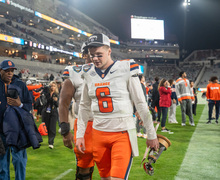3 plays that led to Syracuse’s loss at Clemson, explained
Paul Schlesinger | Staff Photographer
Travis Etienne celebrates one of his two fourth quarter touchdowns that helped Clemson come back from a 10-point deficit.
Syracuse (4-1, 1-1 Atlantic Coast) led Clemson for more than three quarters of its game against then-No.3 Clemson (5-0, 2-0). But things unraveled in the second half. Syracuse mustered three first downs and allowed 20 points in a second half which crumbled the Orange’s chances at an upset road win.
Below is a detailed look at three plays that led to Clemson’s victory.(All screenshots via ESPN.)
Eric Dungey’s interception

At the top of the screen, A.J. Terrell is in tight coverage on Syracuse wide receiver Devin Butler. The middle linebackers will drop back into a “hook to curl” zone, meaning as Butler and Terrell run vertically up the field, the linebackers will cover the space between Butler and Dungey.

As Butler reaches about four yards beyond the line of scrimmage, he’s jammed by Terrell. This slows up Butler and can often affect the timing of routes, which will be a noticeable issue in a few slides.

With Butler running straight ahead, the ball is leaving Dungey’s hand. Terrell, who is looking back at the quarterback, can see this. Butler can’t. In this frame, Terrell starts to break on the ball, while Butler still hasn’t turned back for it.

By the time Butler does turn back, Terrell has already jumped on what appeared to be an underthrown back shoulder pass from Dungey. With Butler not looking until the ball is almost intercepted, it appears to be miscommunication, coupled with a short, line-drive pass which led to this interception. Clemson turned the interception into three points due to the favorable field position.
The failed fourth down
Run-pass option plays have taken over football in recent years. The general scheme is that the line will block as if the play is a run. This makes the defense defend against a rush. At that moment, once the defense commits, the quarterback pulls the ball away from the running back and throws to an open receiver whose defender has been sucked up by the run fake. The key to these plays is that the offensive linemen aren’t called for a penalty due to blocking downfield. Unfortunately for Syracuse, that’s exactly what happened.

Syracuse is lined up in a run-heavy set with tight end Aaron Hackett and fullback Chris Elmore both in the backfield. Clemson is lined up in what Babers described after the game as a Cover 0 look, a form of man coverage. Pay particular attention to Hacket and left tackle Cody Conway (No. 60), the two most outside linemen on the bottom of the image.

As Dungey fakes the handoff to Moe Neal, Hackett rushes toward the Clemson outside linebacker. Conway, an ineligible receiver on this play, isn’t permitted to go beyond three yards past the line of scrimmage. Conway is already at one before Dungey has pulled the ball away from Neal.

Now, Dungey is back to pass. Conway (Oval) is three yards past the line of scrimmage, while Hacket (square) is just engaging with his block about a yard or two off the line. Hackett will have to make contact with his defender and move past him without Conway taking another step.

After Hackett shakes off his defender, and the ball is in the air, Conway has let his defender run free. But that doesn’t change the fact he is nearly five yards from the line of scrimmage. Hackett catches the ball moments later but Conway is flagged for an illegal man downfield penalty. Instead of a first down, Syracuse is moved back five yards and forced to punt to Clemson. The drive granted to the Tigers off the penalty would turn out to be the deciding one.
Travis Etienne’s second touchdown

On Monday, Babers noted that missed tackles led to many of SU’s defensive issues, not elaborate schemes from Clemson. On this play Clemson runs a simple zone blocking scheme in which the linemen often team up on a defensive lineman before moving on to a linebacker. The running back reads the blocks and cuts off the butt of whichever linemen gets the biggest push.

At the start of Travis Etienne’s eventual 28-yard touchdown run, Ryan Guthrie appears to be in proper position. Off the line, he’s taken one step to his right and is eyeing the hole to the right of defensive tackle Chris Slayton (shown by the arrow).

Moments later, Slayton has shifted to the right, into the hole Guthrie originally eyed. Etienne sees this and cuts the run back off his lineman’s right hip. This redirection, known as a zone cut back run, puts Guthrie out of position. Based on where the run is hitting (the backside A gap), Guthrie has flowed too far to his right and won’t be able to collapse back fast enough to make the play.

Here you see Guthrie trying to recover. He dives back at Etienne’s ankles, but it’s too late. The sophomore running back breaks through the weak, low tackle. At the top of the screenshot is safety Andre Cisco, SU’s last chance at a touchdown-saving tackle. Based on where the arrow is pointed (to the right of Etienne) and where Etienne’s hips and eyes are directed (to Cisco’s left), his angle doesn’t look promising.

Fast forward a few seconds and Cisco followed the line he looked at before and Etienne cut the opposite direction. Cisco, like Guthrie, can’t recover from his poor angle and is also forced to leap in desperation. Again, the tackle is too weak for the 210-pound Etienne.

The other Syracuse players can’t recover either and Etienne darts for his second of three touchdowns on the afternoon.
Published on October 1, 2018 at 10:44 pm
Contact Josh: jlschafe@syr.edu | @Schafer_44






